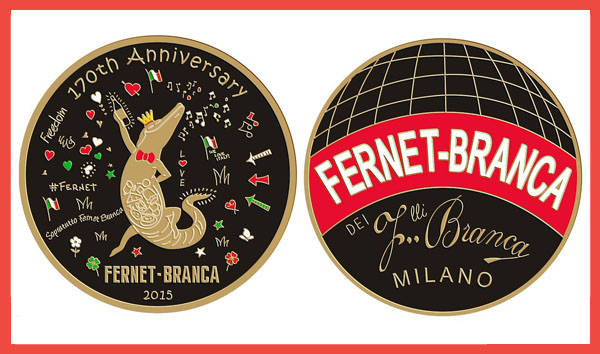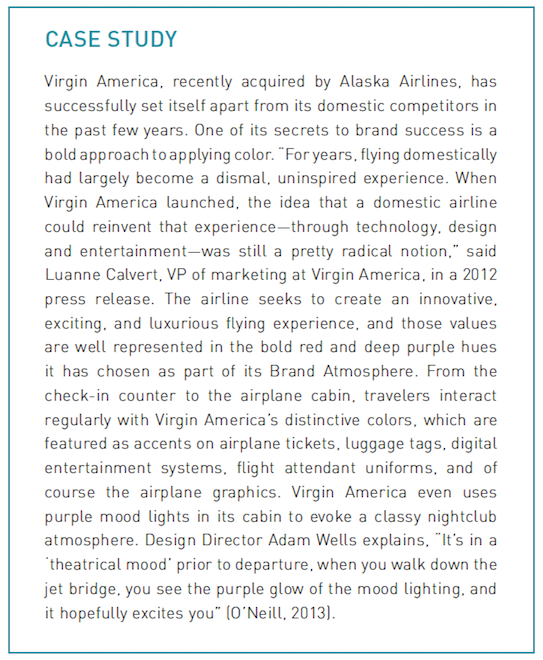Your Brand Launch: Brand Atmosphere
Why Instagram Is Your Brand’s True Homepage – And 3 Ways To Turn It Into A Lead Magnet
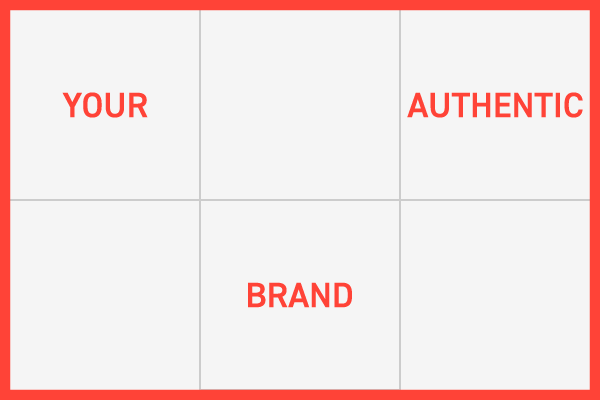
In my brand consultancy, we have a unique process of manifesting a brand’s newly crafted identity. Instead of rolling the design language out in great detail across every touchpoint of a client’s brand, we focus on only a few important pieces that will set the direction and thereby create the brand’s visual and verbal rules.
As part of this process (of showing how a brand can come to life), we recently started spending more time on creating newly branded Instagram accounts for our clients through an initial set of posts. We believe it is just as important, if not more important than the website. Why? Because when you see a company’s Instagram account, you get to know who they really are, what the company really cares about, and even more so, you get to meet the brand that exists today.
The beauty of Instagram is, quite obviously, the platform’s visual appeal. And Instagram for brands is exactly as the name implies: Instantaneous. That is also what most potential visitors seek: Instant gratification.
As of March 2019, Instagram business pages get over 1.5 billion visits a week, “but many entrepreneurs and startups are still ignoring Instagram as a major acquisition channel, mostly because they can’t add links to each post” says Andrew Lee Miller (who I worked with when helping Tinder and Match Group launch a new app).
Andrew, more widely known as AndrewStartups, a startup marketing expert who has led growth for three startup exits, states “Simply put, millions more people are now discovering brands organically through their Instagram account than their website, yet many companies are still spending tens of thousands of dollars optimizing their website, and not a dollar on their Instagram. Hiring a designer, a copywriter and a content strategist for your Instagram will absolutely pay off,” he argues. “It is more important to drive inbound traffic to – and convert on – ‘your new homepage,’ your Instagram page, than almost anywhere else on the web.”
If you are worried about keeping up your account and posting like a true millennial, there is some good news, which should come as a relief: Having a beautifully designed and distinctly on-brand Instagram page that efficiently illustrates your brand, your values, your culture, and your value proposition is what matters to leave a brand impression. Not the forceful, half-hastily constant updates by your intern. Take a breath and start to think of your Instagram page as your up-to-date homepage.
Here are 3 tips from Andrew and myself on how to go about it:
1. Create a longterm, targeted outreach
…and “off-page” social media marketing initiatives that drive new followers to your page every day.
2. Craft an impressive branding and design aesthetic
…coupled with a distinct brand voice, one that is more natural and tongue-in-cheek than currently found on your traditional channels (Those should adapt to your new, authentic voice, eventually).
3. Add a strong call to action
…in the bio with a link that converts. Share something valuable like an offer, a competition, or a free piece of content (white papers, anyone?) that will draw visitors further towards your brand.
It’s time to respect a channel that will instantaneously provide an up-to-date overview of your brand at its most authentic self. Not only that, but you will be able to sit back and watch leads come in from a source you least expected.
How Brian Scudamore, Whose Brands Are Making A Million Dollars A Day, Leads With Brand Thinking
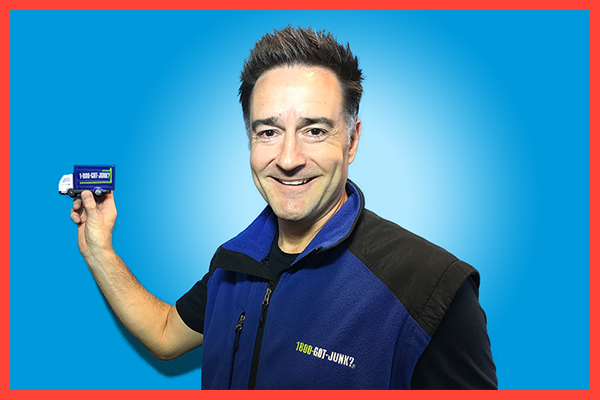
An edited version of this interview was first published in my column on Grit Daily on 02/19/19.
I devoted my professional career to branding, from authoring books on the subject, to holding workshops and deriving brands through my consultancy, I live and breathe branding. Yet, when I sat down with serial entrepreneur Brian Scudamore, who I met when we were both mentoring at Guy Raz’s How I Built This Summit, I changed seats and had Brian share brand advice instead of myself.
Brian just released the book WTF (Willing to Fail): How Failure Can Be Your Key to Success and is making a splash in the business world. And that is mainly because he knows a thing or two about how to build a brand as he has started a business in college which today brings in an average of a million dollars a day (yes, you read that correctly!) and he is on the path to becoming a billion dollar company.
Brian Scudamore is a serial entrepreneur and author who has always taken the road less traveled. At just 19 years old, he pioneered the industry of professional junk removal with 1-800 GOT-JUNK, turning a chore people avoid into an exceptional customer service experience, changing the narrative of an entire industry in the process. When he ran out of new markets to expand to he scaled the business into three more home service brands under the O2E brands umbrella: WOW One Day Painting, You Move Me, and Shack Shine.
In between appearances on Oprah and Dr. Phil, and on the morning where he made it onto the home page of CNN.com, little me was fortunate to score time on his schedule to talk about branding, culture, and naturally about failures in the journey of an entrepreneur.
How do you get into that mindset of embracing failures? It’s so easy to say ‘fail forward,’ but most entrepreneurs are extremely driven, many have a ginormous ego and they often take failures very personally. How do you run towards failure with open arms?
So I’ve learned to ask myself one question in this journey. When I am failing, when I am having a difficult moment, when I am feeling depressed, whatever is going on that seems and feels like a failure, I ask myself one powerful question: What’s one potentially awesome thing that can come from this tough situation? And I start to brainstorm and sometimes I create a big list, and I go wow, thank goodness, this is exciting! How awesome that I am failing, because look at all these amazing things that can happen as a result of this learning. I think it’s a perception. I think that people need to really, really look at why is this failure happening and trusting that you’re in the right place at the right time and that while the mistake might hurt, it is going to get you to a better place if you so choose.
What was a ginormous brand fail that you went through with your venture?
I think one of the biggest ones was my first big flop. I had eleven employees, and they say one bad apple spoils the whole bunch. So I end up getting rid of my entire company. I have nine bad apples, and I sat down with them, and I said guys, I gotta let you know that I think I found the wrong people. I haven’t treated you right. I haven’t given you the love and support you need to be successful, and I’m making a tough decision here, but we’re gonna part ways. So I went from a company of twelve, myself and eleven, down to one. It was just me hauling junk. It was just me answering phones and trying to rehire. But I learned a valuable lesson from that failure that your very first employee has to be amazing because that person is going to spread the culture, the vibe, and the feeling of the business and that you need to really build on finding the right people and treating them right, and it’s made a huge difference. I look at our company of over five hundred people today and how amazing for us to feel so proud about the type of culture we have. It would have never have happened if I hadn’t made some of the mistakes I did.
Let’s talk about company culture a bit because I’m a firm believer that if done right, any startup should invest time and energy into creating a strong culture that can basically serve as the platform upon which everything else can be built. How important are core values to you?
Jim Collins wrote a book called Good to Great, one of my favorite books, and he said you’ve got to have values. It doesn’t matter what they are as long as they’re your values. So we went and took a little retreat to Bone Island, a little island near our office, and I said to my team at the time, maybe fifteen years ago, I said what are our values? What words can describe who we are, not who we want to be or who we are trying to be, but who we are today? What are those words? We took Post-It notes, we put them all up on these big windows, and we grouped all four hundred Post-Its with different words into four distinct categories: Passion, Integrity, Professionalism, and Empathy. And when we looked at those words they made the acronym of PIPE. It turned into this interesting tool around ‘the junkyard,’ our head office, where we would say to people: “I don’t know if that decision was very PIPE?,” or “I don’t know if that behavior was very PIPE. It’s not in line with our values.” And so values can’t just be a poster on a wall. Values have to be something that you hold your team, your people, accountable to and you hold yourself accountable to. If you’re not displaying passion, if you’re not displaying integrity, how can you take a look at yourself in the mirror and say what do I need to change? Let me be vulnerable and admit my mistake and then let me make sure that we are living, all of us, each and every day, by our values.
With building a franchise there is very tight brand management and brand stewardship involved, but equally as important is consistent brand design. What are some of the key steps that you had to go through to create a platform of tight brand rules and guidelines that also empower franchise owners a little bit, rather than solely restrict them?
I sat down and I read a book called The E-Myth by Michael Gerber. Michael and I have become friends. He is eighty-two years old. He wrote my favorite book on the planet and what the book talks about is people don’t fail, systems do. Take everything in your business, and it doesn’t matter if you’re running a brand agency, or a junk removal company, take everything you do and write down on one page what’s that one best practice and how would you teach someone else to do it? So how do you load a truck, how do you answer the phone in the call center and what’s the introduction? What’s that high energy and how do you talk to the customer? How do you market the business? How do you do your accounting? Every single piece of the puzzle has to be down on one page simplified. Here are the best practices and steps. You start with the right recruiting systems to find the right people, the right training systems to make sure that they’re trained properly, and you’ve got good people doing the right stuff and then the operating systems to keep them great. If you think back to when I fired that entire team, a team with eleven people, the biggest missing system was not those people. They didn’t fail, it was me failing because I didn’t have the right recruiting systems and then I didn’t have the right training systems and so it all kind of compounded in a massive failure, but it taught me and inspired me to end up finding that book not long after to really set up the processes in my business. If you’re trying to build a franchise, franchise brands all they are is proven recipe. A recipe that you can replicate that others can follow with the same success that you’ve had.
Especially with the junk business, you have to give instructions on how to change the narrative and change customer behavior to embrace the company of a franchisee as a brand rather than just another junk hauling man. How did you go about that? A lot of it was great uniforms and exceptional service, but how did you start as a brand, start talking about junk in a way where people felt like oh, 1-800-GOT-JUNK is an actual brand and not just local people who are driving around picking up my junk?
I think it was just years and years of consistency of the blue and green 1-800- GOT-JUNK brand and logo. Our trucks parked as massive billboards across every city that we operate in. It was the PR. All these things that continued to happen, it was building that press engine. It was building that consistency of the brand and that people wanted to be a part of the winning story. Our success has helped, but these overnight success stories as they say, sure take a long time. This wasn’t something that just happened in a year or two years, next month will be our thirtieth anniversary as a company.
You are a brand genius. You have done more than most people will ever do with one brand. What does branding mean to you?
Branding to me is a look and feel, a connection. Think of a person. You look at Oprah Winfrey, the way she dresses, the personality, the energy she’s got, her intelligence, the way she can connect with human beings on humanity. She is a great brand. Businesses have to do the same thing. How do you look? How do you act? Your values, what’s the brand feel like and what makes you so special and how do you differentiate yourself from anyone else in the world? Look at brands, here in front of me I’ve got my iPhone. Some people have an Android device. Both are great, both are brands. They’re very, very different and they appeal to different people for different reasons. I think that’s the key. it is just understanding that a brand is a feeling, a look and feel and how do you strategically create it in the right way?
What in your eyes is the most important part about branding that any startup should invest in getting right in the beginning? What is this one thing with your brand you have to get right in the beginning?
I think the one thing is just deciding what the brand will look and feel like and stick to it. Just really be consistent. Is McDonald’s the greatest looking logo in the world? Eh, the colors don’t appeal to me, but you know what they’ve done exceptionally well? They’ve been consistent over time, they have not strayed from their brand look and feel. So, I think it’s more important just to pick something and go, you know what, we are going to be proud, we’re going to be all in and stick with it.
What Any Brand Needs To Learn From Amazon’s Physical Bookstore Experience
I just spent an hour at Amazon. Not on Amazon, at Amazon.
As an author with a second book release upon me, I study book marketing up close hence I just had to make a pilgrimage to Los Angeles’ first physical Amazon bookstore. It opened two weeks ago as part of the Westfield Century City Mall‘s universally talked about staggering 1$ Billion re-model (…and we thought retail was dead).

I was doubtful when I initially heard about Amazon going into physical storefronts thereby going back to the business model they once so successfully disrupted many years ago. Well, my doubt was quickly turned into exhilaration as Amazon did not simply open a storefront, they changed the way consumers experience products offline – with a whole lot of help from online insights.
Amazon successfully and holistically transformed what worked online into a physical brand experience. It took full advantage of its massive amounts of data, to my delight. At the AmazonBooks store, you are greeted with shelves titled ‘Highly Rated – 4.8 Stars & Above’ or ‘100 Books to Read in a Lifetime – Our Picks from the Amazon.com List.’ Not surprisingly, it works and it pulls you into a curated, and more importantly, customer-verified, experience. Do you trust that Maggie from the local bookstore has a ‘Staff Pick’ or do you trust hundreds, thousands, millions of readers just like yourself? Sorry, Maggie, I am all up for supporting local stores, but that was an easy pick.
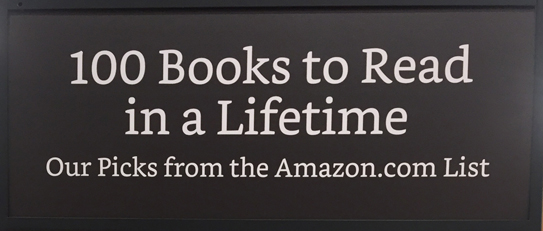
Not so quick though, as Amazon knows it needs to, and should, make the experience a local one. ‘Read Local – Notable and Highly Rated Los Angeles Books’ as well as top-rated books from readers in L.A. are showcased prominently. Another nice touch is Amazon’s integration with the online reader community of Goodreads, albeit logical as Amazon acquired the site in 2013. Still, seeing ‘Goodreads Most-Read Classics’ and ‘Book Club Picks from Goodreads’ adds more intrigue to the books stacked in traditional bookstore style underneath. Each of these components engages, builds trust, and keeps you in the store longer.
But let’s not paint a picture of Amazon showcasing only the proven books, by the biggest authors, on their rather limited shelf-space. You’ll see books of unknown authors, some that are rated only a few times, next to the big sellers. One book particularly stood out (Innovating by Luis Perez-Breva and Nick Fuhrer) as Amazon’s description reads ‘100% of reviewers rated this item 5 stars.’ The book only had 21 reviews in total. This makes me feel like I am discovering something, which is one of the key ingredients of a great book store.
Amazon also picks customer reviews to showcase, rather than the author’s book description, or an Amazon editorial review, which makes the experience even more personable.
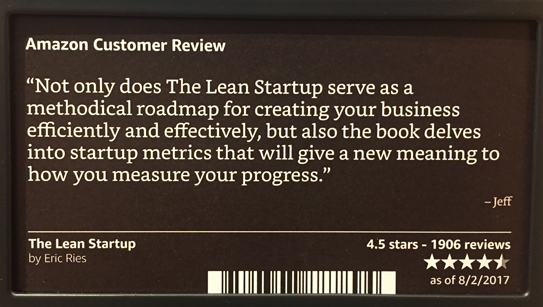
The last store curation effort that made my heart speed up was the huge shelf-space dedicated to ‘If you like this, you’ll love these.’ A key component of the Amazon.com shopping experience, seeing a book you liked on a shelf with six you never heard of next to them, suggesting that you’ll love them is a sure-fire win in any customer browsing experience.
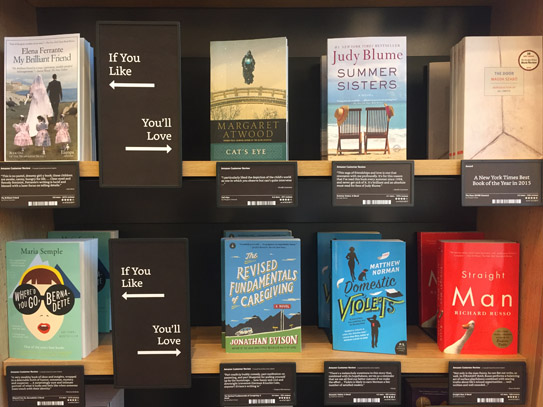
Besides taking away that Amazon has nailed its data integration into its retail environment – not to anyone’s surprise – what can you, as a CMO of a brand or as a startup entrepreneur learn and immediately utilize from its success?
Map your online customer brand experience, then take it offline.
It feels upside down, and precisely that is Amazon’s amazing ‘Zag’ in this instance. How do users behave on your site, what content do they read, what call-to-actions do they skip, which offerings do they spend the most time on, and so on and so forth. Study it. It’s there, you just have to start digging into it.
Then take that data and make use of it in all the ways you conduct business offline. As many of you don’t have retail stores that you can start experimenting with, you may think this is not applicable to your brand. Think again: sales presentations, prospect case study conversations, tradeshow experience designs, new product launch considerations, brand initiative ideas, brand narrative adjustments – you name it. That online journey can be a game-changer in the way you engage with your customer/consumer/member everywhere else.
Much has been said about leveraging latent data and creating actionable new data points for brands of all sizes to utilize, but the essence of what Amazon did is actually rather simple at heart: Study the trail your online users leave behind and use it to educate a new or revised, deeply educated and highly personalized offline brand experience.
What we learn from AmazonBooks is that these insights can even be used to craft a brand narrative for a new brand extension: Translating what works naturally online (‘if you like this – you may like that‘ as an example) for their brand and making it work as a novelty in an offline experience that is 100% true to Amazon’s brand essence. It’s not just connecting data for increased sales, it is doing so in a way that is intrinsically true to the core brand philosophy.
Amazon’s user journeys helped create an offline sub-brand. It may be time to look at your brand’s online data, create your user journeys and translate them into successful offline experiences. It will re-affirm, or re-educate your brand’s essence, or perhaps it will even inspire you to launch a new brand extension.
Until then, you can find me at Amazon as on Amazon is just too one-dimensional and old-fashioned.
Brand Colors – Not A Science Nor An Art, But A Strategy
Life is full of give and take, and so at times one finds himself partaking in experiences that one would usually not seek out on their own. My lovely wife convinced me to partake in one such experience last week. We visited the ‘guru of aura photography’ as she made a rare L.A. stop – in form of a popup inside a hip retail shop – and had our pictures taken. Yes, there is such a thing, and it’s apparently currently not just a thing, but the thing. Gwyneth Paltrow does it, need I say more? And now, so have I.
Please, go ahead, meet my aura:
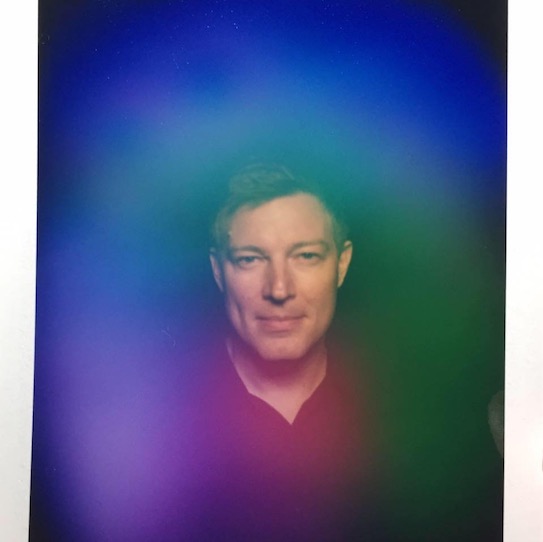
As it goes more often than not when opening yourself up to new experiences, this actually was quite enriching. It was fun to partake in a mythical-visual experiment of sorts, and my aura seems to be in good shape too; can’t you tell? Well, perhaps you can, at least a little bit. As for me, without the detailed info (or shall I say ‘reading’) I received after the picture was taken, I only knew that blue/purple was about trust and loyalty, and comparing it to the many other aura portraits I looked at online, prior to receiving the professional insights, I realized that it had quite a personality of its own. Everything else that I learned about the meaning of these particular colors and their locations surrounding my image directly from the photographer, I would have never guessed by just looking at the colors without a full de-briefing.
That experience also quite nicely summed up my rule of thumb when it comes to the art and science of using colors in branding:
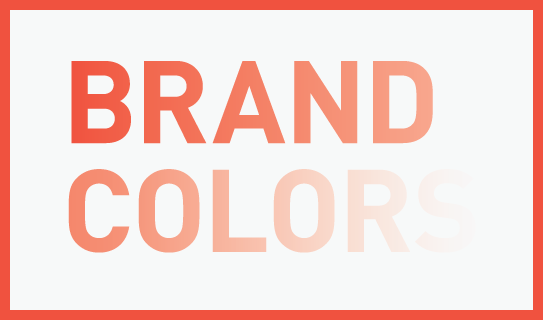
Many books have been written about how to use colors in logos, the meaning of colors and how colors make consumers feel. I even dedicated 3 pages of my book on branding to the significance of color. Color makes an impression and it matters, absolutely, but just how much should the deeper meaning of color, that us ‘branders’ know about, really influence you and your creative team when crafting your brand’s identity?
My advice to you: Don’t read too much into the meaning of colors. It’s less a science and an art than it is a strategy.
Just because blue stands for trust, your FinTech startup should not choose blue for its logo. Your restaurant franchise should not immediately pick yellow or orange as the key color ingredient because it evokes appetite. If you go by the book of colors, you will never stand out from your direct competitors as they read that very same book. As far as my book of branding is concerned, it’s all about you not blending in, and that includes the color choices you make.
To celebrate Virgin America in light of the recent sad news, here is how they used color to stand out, via a case study from “How to Launch a Brand:”
Yes, colors matter, especially when you use them to stand out.
As you start researching the meaning of colors, stop. Instead spend ample time researching your competitor’s colors, then go the complete opposite route and pick colors that truly stand out within your vertical.
But, as most things in life go, this too is a give and take, so ensure the colors you and your creative team pick, as different as they may be from your competitors, will still support your brand’s personality and positioning. That may have been obvious, then again, so was my aura.
Branding Your Venture: Seen It All? Listen Up!
It may seem as though I have been suffering writer’s block so far this year, but fear not as I am knee-deep into writing my second book, which I am excited to share more about in the months to come. This is my excuse: writing has kept me from writing, but – better late than never – here I am wishing you a Happy New Year!
Besides writing during the holidays I did what most do as they start winding down: I was glued one too many hours to my Facebook timeline. Filtering through the current war in politics to find the few posts of friends that were non-political in nature turned productive once I saw my friend Chris’ hilarious post: Chris was on a plane with his wife, noting he got a free upgrade to first class, and, without hesitation, left her behind in Economy to live the good life. I was intrigued and awaited the backlash in the comments box, which sure enough came trickling in one after another at mesmerizing speeds. His reply? “I can’t hear you over the bubbles of the champagne.”
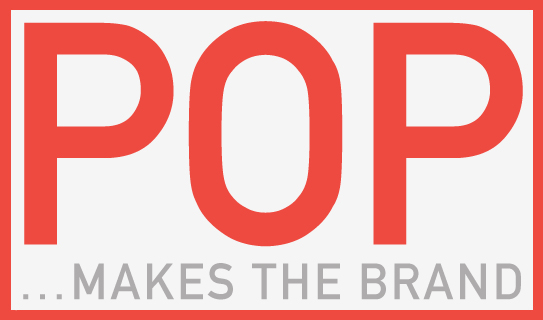
I thought it was witty, hilarious and it evoked an immediate sense of space and time. It made me recall the sound of champagne (as well as the witty POP champagne brand named after the sound of the cork popping – and for being a ‘Product Of Pommery’) and it made me recall memories of many great celebratory situations and, yes, the times I too got my flight upgrades.
I spend a lot of time writing about how new brands can stand out and connect with a target audience; strategically, visually and verbally. How your brand looks and feels is crucial, how it behaves existential, but how does your brand sound? Does your brand sound like anything, and if not, should it?
A known advertising routine for Fortune 5000 companies, sound is often times used in audio logos (‘sonic branding’ –Intel comes to mind, well, ears) which sonically enhance the moment in which a brand’s logo is being revealed, as well as memorable jingles, which are oftentimes so memorable that they turn into full-on annoying. Sounds are extremely powerful emotion-triggers. And just like it is the case with the return of print (book sales are up 3.3% in 2016, third growth year in a row), the use of branded audio is a neglected yet powerful way of brand communication and immersion. Because it is not a standard staple for new ventures to be using (yet it became quite affordable to create), it presents a great way for your startup to stand out and to further strengthen the connection points with your audience.
Start by being aware of how your product sounds when you plug it in, when the task is finished in your app, when the brand icon appears, when the videos start and end? Have you given your product, or brand, sounds, or do certain interactions with your physical product already make unique sounds of their own? If so, how can these be leveraged – packaged to be re-used – so that you can lift that moment in time when your customer is fully immersed in your brand and bring it back to other times in your brand journey?
This year, let’s look at empathy in an additional way: let’s not only listen to our audience, let’s listen to our products and make them connect with our audience sonically, creating emotional connections and stories that turn into memories.
So unless you don’t get any flashbacks when WHAM’s Last Christmas starts playing every December, and especially after this last christmas, you will agree that sound indeed is a powerful trigger of memories. Let’s make more use of it and create some sound memories with our brands.
Public Relations And Brand Overlap Far More Than You Think
This article was written by Rebekah Iliff and was originally published by Forbes on 09/01/16.
In below article, Rebekah Iliff, Chief Strategy Officer at AirPR, discusses the intersection of branding and PR; an intersection too obvious to ignore, yet one that remains ignored too often. With her permission, and as my book is being referenced throughout (well, thank you!), I now like to share her thoughts with the readers of The New Brand Post. It goes something like this:
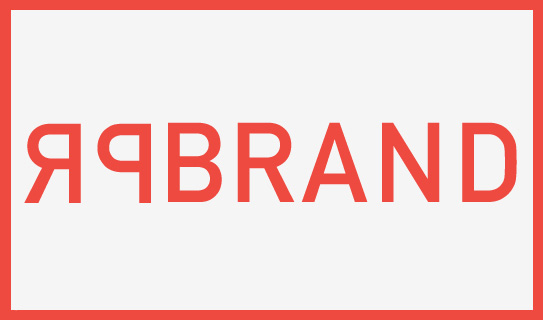
Without intending to, a company’s departments sometimes end up working in ineffective silos. A tech team without communications professionals can’t shed light on their achievements uber-effectively. An innovative ASMR advertising campaign can’t get many kudos without public relations, and the news of a rebrand can’t spread as fast organically as it can with media outreach. Stitching together cross-functional teams leads to greater innovation and opportunity.
At the same time, there’s a bit of a stigma about bringing too many cooks into the kitchen. Does your art director really need to help approve the imagery you’re sending to a journalist? Does your public relations department really need to know if the copy team is writing a spur-of-the-moment April Fool’s Day display ad before it goes live? In both situations, the answer is yes.
It may take longer to loop in other teams, but it’s worth it. Which brings us to two teams that frequently overlap without many people realizing it: public relations and brand strategy. These teams are often severed from contact, even though it’s paramount that they work together. Together, they are more effective, as both teams deal with messaging, public perception and customer touch points.
Fabian Geyrhalter, Principal and Founder of Los Angeles-based design and branding agency FINIEN, recently released the second edition of How to Launch a Brand, which covers everything from brand positioning and naming to brand identity. He’s launched more than 50 brands – large and small – and knows that brand strategy is more effective when it’s backed by an integrated PR and communications plan. Here are three ways public relations and brand strategy teams are related and why it’s important, according to Geyrhalter, a fellow Forbes Agency Council member.
1. PR and brand teams both focus scrupulously on messaging penetration
While copywriters, often living on branding or creative teams, work to align copy with a brand’s voice guidelines, public relations teams align messaging with a brand’s key ideas. In that sense, branding/creative and PR teams are the two wings holding a company accountable for what it communicates to the public, from board members to customers and journalists.
“Consumers respond to brands that have a coherent and straightforward message,” Geyrhalter writes in his book. “Equally important to your message is selecting a distinctive voice and persona for your company. The audience demands authenticity, and your brand’s voice must be authentic and transparent.”
As an executive at a PR tech company, I see Fitbit as a successful brand that has these teams in coordination. Think about Fitbit’s brand voice: It’s clear, concise, encouraging and motivational. If copywriting contradicts the foundational messaging a PR team is using, misalignment occurs and it can chip away at credibility long term. Imagine if Fitbit sent you a marketing email encouraging you to get a few extra thousand steps in today, while its CEO was quoted in a popular health magazine saying steps don’t matter, only calories. Customers may not notice, but journalists likely would; “misaligned” isn’t a way you want your brand to be perceived.
2. Public perception is jointly owned by public relations and brand
While copywriting and graphic designers and/or UX design control public perception of a brand from a customer standpoint, public relations and communications teams control public perception from the standpoint of investors, board members, influencers (from journalists and analysts to bloggers), and more.
It’s like the two sides of a vanity mirror. On the magnified side, PR people share intricate details with the press who view brands under a microscope. The other side shows a clear, customer-facing view of said brand. Both are needed in order to properly display your “face.”
3. Branding and public relations both pivot upon personas and personalities
Both branding and public relations teams give companies real, human faces through characters and spokespeople, some of whom are real employees, some of whom are figments of our imaginations.
“Characters give the audience someone to root for and follow,” writes Geyrhalter, referencing Mr. Clean, Virgin’s Richard Branson, and Dos Equis’ “Most Interesting Man in the World” as personalities that have garnered impressive followings.
Natural foods brand Kashi is another example Geyrhalter mentions in his book. Kashi has taken a different approach in leveraging its real employees as brand ambassadors, showcasing how its actual team members live and breathe the Kashi lifestyle.
“Thinking of your brand as a person will help you create an authentic voice that will connect with consumers,” writes Geyrhalter. He suggests writing a list of adjectives that describe your brand or writing a faux obituary that includes a list of life accomplishments to better illustrate these personas. How would the brand persona be remembered?
In public relations and communications, real spokespeople – from CEOs who can speak to high-level strategy to CFOs who can talk publicly about financial matters such as an IPO behind a brand are what the public and journalists want (versus boilerplate messaging penned by a PR professional).
Next time you’re poised to launch a PR campaign, perhaps take a moment to ask yourself if the brand is represented fully in every aspect of your company’s outward facing narrative. In other words, are you certain that brand and communications are effectively working together?
Coin It: 3 Reasons Why Your Venture Needs To Develop Nomenclature
Getting a venture off the ground is tough. Competing against similar startups and established players along the way is even tougher.
One tool to add to your ‘brand insurance box’ (you know, the things you do that make your venture a strong brand) is also one of the simplest and most valuable branding efforts you can undertake: creating a term you can own.
Below I outline 3 reasons why owning your language will leave a quantifiable mark on your brand:
1. It Differentiates You From Your Competitors
Don’t come up with a term for branding’s sake, rather evolve it naturally. The last thing you want to do is to confuse your customer with strange lingo, instead you want to inform and educate. Think of industry terms that are being used within your segment by your customers – are they all clearly saying what you’d want them to say, or are some misguiding, perhaps even outdated based on the solution your venture offers? Some you might flat-out hate or poke fun at regularly for good reason.
I, for instance, hated the term ‘brand collateral’ to describe the pieces a brand uses to communicate its brand values, visuals and language to clients, consumers and prospects. During the process of writing the book ‘How to Launch a Brand,’ I demanded a better term for the visual and verbal brand communication pieces and I coined the term ‘Brand Atmospheres.’ To me it made for a much stronger and all-encompassing description that felt logical rather than confusing. I trademarked the term, linked it to our web site, named one of four chapters in the book after it and soon prospects started talking about how ‘they needed to revisit their Brand Atmospheres.’ Long gone were brand collateral conversations.
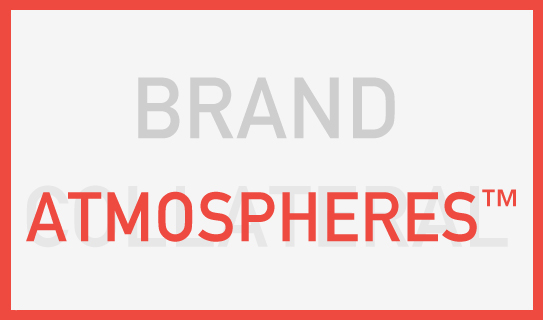
It’s not on the scale of someone asking for a Kleenex or making a Xerox of a document, but within my niche it made me realize just how much of a differentiator it became to have marked a term that is being used in conversations by prospect clients. It strengthens the brand perception and creates an immediate relationship between prospect and provider.
2. It Establishes Immediate Trust
Maybe you have a process, a specific way of doing things? Will you call it ‘Our unique process’ or will you actually give it a unique name that describes your thinking in a better way? I named our one day brand strategy workshop for startups ‘Resonaid,’ to further describe the function of the workshop: It serves as an aid to make your brand resonate with its customer from the get-go. It turned our process into a product that is instantly tangible as well as ownable.
The unique thing you do, whatever it may be, give it a unique name. If it’s unique it deserves it; perhaps even demands it.
People trust something you truly own (up to). It not only adds importance, it also makes it unique to you, which relates to your offering as being substantial, or substantially better than the one of your competitors. Most founders start at the brand name and end at the product name missing out on all the terms in between, which establish trust along the way of the decision making process.
3. It Creates Intrigue And Belonging
Creating a lingo is like your own secret language, which won’t remain a mystery for long. It’s like writing with invisible ink, only that everyone will ask you to see it. Everyone will want to be ‘in the know’ and once they are, they will be darn proud of it. They have a sense of belonging. They don’t grab donuts at Strange Donuts in St. Louis, no, they grab dones. They call me and ask for a Resonaid workshop, not about the ‘brand creation’ workshop.
Adding intrigue to a brand is every marketers goal. Usually that involves big campaigns on even bigger budgets. By adding unique nomenclature to your branding efforts, you hit that intrigue mark on a much tighter budget.
While other startups try to become ‘the Uber of their industry’ why don’t you take the direction of becoming ‘the Kleenex of your industry’ instead? They will call you by your name. Promised.
‘This Black Friday, We’re Closing All Our 143 Stores’
See grain. Go against it.
In a wonderful promotion that goes straight to the heart of its brand, outdoors consumer product brand REI (Recreational Equipment Inc) decided to remain closed this Black Friday. It will instead pay its employees to spend the day outside. An idea that is so nuts for a big retailer, that will lose important revenue on the biggest revenue generating day of the year, that would never go past any Board of Directors or Shareholders…that it makes for the perfect promotion for REI to pull off.
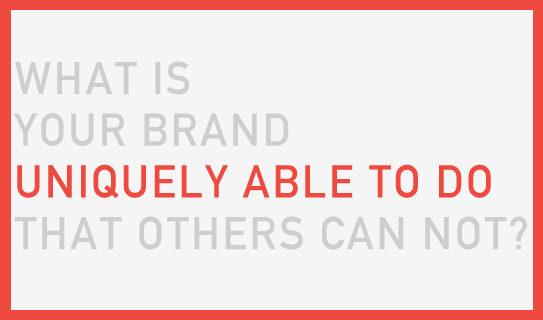
That is the question I always ask startups as I help define their brand strategy. What is it that makes you so unique and how can you leverage your uniqueness to gain hearts?
REI is a co-op. It is owned by its members, its shoppers, by all of us. If anyone, they are uniquely able to ‘#optoutside.’ A genius move that goes deep into the heart of the outdoors brand and its loyal audience: “While the rest of the world is fighting it out in the aisles, we hope to see you in the great outdoors.” Opt Outside. The revenue that they will (likely) lose that day, they are gaining in lifelong, renewed, love by its members. A love that is worth every penny (used solely as a metaphor) of their Black Friday losses. Money can’t buy what this strategy will give back to their brand.
What is your takeaway?
Well, what is your startup uniquely able to do? Define and follow it to connect with your audience in deeper, more meaningful and plenty of profitable ways. Oh, one more detail: Have the courage to execute upon it.
Can’t Steal Our Vibe
A little while ago I was driving through Venice (California) and noticed a surf shop that must have recently gotten broken into.
I was mesmerized and quickly snapped a picture out of the car:
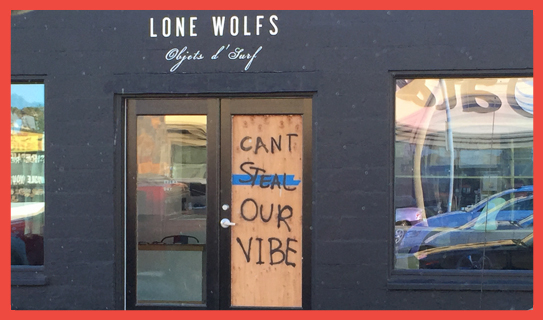
To me these 4 simple words so masterfully describe how we help our clients derive their company’s true soul. What we are really doing is determining the ‘vibe’. A vibe that you can fully embody and that others can fully embrace. A vibe that one day turns into your norm and that you spread with ease. A vibe that if competitors come in, they can no longer simply steal.
That vibe is how Keith Moon played the drums or how Craig Kelly surfed the snow. There have been plenty of amazing drummers and snowboarders, but they can’t touch that style, that vibe.
How poppin makes receiving a stapler in the mail exciting? It’s their vibe.
That vibe is the foundation to their brand.
“Can’t Steal Our Vibe.” Street culture poetry that every company transitioning into a brand can learn from.
If all fails, if all gets stolen, what does your brand still own? What is that foundation that you can rebuild upon with ease, because it is based on passion and emotions and not products and numbers?
